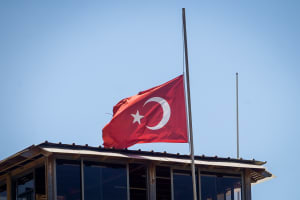What happened in Gaza before Islam? A look into its New Testament and Christian era
The history of Gaza – part 2 of 4

The city of Gaza is mentioned in scripture as early as Genesis 10, right after the flood. Although not central, it’s mentioned a number of times throughout the Bible, and it has been ruled by an incredibly huge variety of ancient and modern kingdoms.
Ancient Egypt and modern Egypt; ancient Philistine and modern Palestine; ancient Israel and modern Israel; ancient Greece, and crusader kingdoms; ancient Rome and modern British Empire; ancient Ottoman Empire and involvement by modern Turkey; ancient Islamic caliphates and modern attempts at Islamic caliphates.
It has been sacked by Mongols and destroyed by plagues and wars; it was the site of the first suicide attack in history; and it was inhabited or visited by people as diverse as Samson and Delilah, St. Porphyrius, Rabbi Israel Najara, the false Messiah Shabtai Zvi, Napoleon Bonaparte; and it is the burial site of Muhammad’s great-grandfather.
Just imagine what an amazing place it would be to visit if it weren’t a constant war zone.
No one really knows where the name “Gaza” comes from. Maybe it had a meaning in an ancient forgotten Anakite or Canaanite dialect. The initial sound is not really a “G”– it’s a guttural “R”-sound common in Semitic languages, often transcribed as “Gh” in European languages. The European transcription “Gaza” was already used by the ancient Greeks. In Modern Hebrew, this sound fell away, which is why Gaza is called “Azza” in Hebrew. There’s a theory that the name comes from a Canaanite word for “strength,” but since the ancient word for strength doesn’t use that “gh” sound at all, it’s probably not true.
In the last article, we left off with the Philistines of Gaza being deported by Babylon and disappearing from history. So, what happened to the city of Gaza after that? Other people, probably mostly Phoenicians from the area of today’s Lebanon, resettled the area.
Gaza actually thrived and flourished under the subsequent Persian rule that replaced the Babylonians. The Jews returned and rebuilt the temple in Jerusalem under Ezra and Nehemiah, but they were in Jerusalem and the area closest to it, and never reached quite as far as Gaza.
A few centuries later, a guy named Alexander the Great came along in 332 B.C. and totally demolished Gaza after two months of siege. Maybe Israel should learn a thing or two from him. Or maybe not.
Everyone in Gaza was killed or taken captive, and Alexander resettled the city with Greeks and loyal Bedouins, turning it into a Greek polis. After Alexander’s death and the division of his kingdom, Gaza first fell under the Egyptian Ptolemaic Kingdom, and after 200 B.C., the Seleucid Kingdom, ruled from Antioch. During this era, Gaza was a mixed city, and there was a thriving Jewish community in it. The Nabateans, who had their capital in Petra, used Gaza as their port city to the Mediterranean, and established caravans and trade routes between Petra and Gaza.
However, as you might know, it was during this Hellenistic period that the Maccabees revolted and made Judah an independent kingdom, establishing the holiday of Hanukkah. During that war, the Maccabean army also destroyed Gaza in 145 B.C. and made themselves unpopular. Gaza didn’t end up being a part of their kingdom, so the inhabitants of Gaza were pretty hostile to the Jewish kingdom (where do I recognize that?)
The Hasmonean Kingdom was first semi-autonomous under the Seleucids, but became fully independent in 110 B.C. In the year 96 B.C., the Israeli king Alexander Yannai conquered Gaza after a long siege and a bloody battle with thousands dead. Gaza was finally brought under Judean rule and cut off from the Nabateans.
But then the Romans arrived. They rebuilt Gaza in 63 B.C. and, once again, Gaza became this international, mixed city with a large Jewish community but also many Greeks, Romans, Phoenicians, Nabateans, Egyptians, Persians, and Arabs, just like Jaffa and Caesarea and so many other Mediterranean port cities. It soon became a part of the vassal kingdom of Herod the Great, and after his death, annexed to the Roman province of Syria.
Gaza is mentioned once in the New Testament, when the Ethiopian eunuch hears the gospel from Philip (Acts 8:26-39) on the road from Jerusalem to Gaza. It makes sense that, traveling from Ethiopia to Jerusalem, he would go through Gaza and, on his return, take the main road from Jerusalem to Gaza. According to church tradition, the site of his baptism was the Ein Haniya Spring, south of Jerusalem near the southern entrance route, which would place the baptism very close to Jerusalem and pretty far from Gaza.
There is an old church tradition that says Philemon – to whom the 'letter to Philemon' was written – was the bishop of Gaza, but there’s no evidence of that, nor does it seem very plausible.
When the Jewish revolt against Rome broke out, Jewish forces attacked and burned down Gaza in 66 A.D., but the Romans rebuilt it quickly, and it became a station for Titus, going from Egypt to Jerusalem and back. After the destruction of Jerusalem in 70 A.D., some of the Jewish slaves were sold by the Romans in Gaza.
In 106 A.D., Roman Emperor Trajan expanded his territory and gobbled up the Negev Desert and Petra, making the Nabateans part of the Roman Empire, and finally, the Nabateans once again had access to their former Mediterranean port. The Romans granted privileges to the city and built many pagan temples in the city, as well as stadiums. After the Jews failed in the Bar Kochba Revolt in 132 A.D., they were once again sold into slavery by the Romans in Gaza.
Under the Roman Empire, Gaza kept thriving with a lot of pagan worship. There were Christians, but they were persecuted. Even after the Roman Empire became Christian (which is the point at which we start calling it the Byzantine Empire instead), Gaza remained mostly pagan, and persecuted their Christians. It was a man known as St. Porphyrius who spearheaded the Christianization of Gaza between 396 to 420 A.D., building churches and destroying pagan temples.
The city also grew and flourished. They cultivated, produced, and exported a lot of wine. It was a key trading point between the desert and the Mediterranean, and so many Arabs would also pass by. And then a certain Arab trader from the Quraysh tribe in Mecca named Hashim ibn Abd Manaf happened to fall ill on a journey, and died when he was in Gaza, where he was buried. And he happened to be the great-grandfather of Muhammad. Until today, the descendants of Muhammad, including the Jordanian royal family, are all called the Hashemites, named after him. And he was buried right there, in Gaza, in 497 A.D.
In the 6th century, the persecution against Jews and Christians seemed to have calmed down. The local Jewish community built a large synagogue in 508 A.D. with a mosaic floor depicting King David and lots of animals and birds. The synagogue was excavated in the 1960s and the mosaic was moved to an Israeli museum. It can be seen today at Israel's Museum of the Good Samaritan, near Ma'ale Adumim. Just imagine how many additional amazing archaeological finds could have been found there if it weren’t a constant war zone. In 2023, this synagogue was briefly used by religious Israeli soldiers as a synagogue.
The 6th century is also the Christian golden era in Gaza, with a famous rhetorical school in the city where many important Christian figures who later became saints lived and operated. Gaza was also a starting point for pilgrimages into the Sinai Peninsula. It housed a library that could compete with those of Alexandria and Athens.
Some of the most important philosophers of this era, known as “late antiquity,” worked and taught in Gaza, including Aeneas, Procopius, and Choricius. They wrote works of philosophy, theology, and Bible commentaries that are still widely read and studied. Influential early ascetics and monastic writers, like Isaiah the Solitary and Barsanuphius of Gaza, were also active in Gaza during this time.
And then a man from Mecca named Muhammad came along. He visited Gaza at least twice during this era, in his early 20s, arriving with the summer caravans alongside the Meccan merchant Khadija, who later became his first wife. Without a doubt, he listened and learned a lot from the Christians, Jews, and Greek philosophers active in the city. And then he went home and became a prophet. And much later, after his death, his followers conquered the city.
Click here to read part 1: The biblical history of Gaza: From Genesis to the Philistines
And in part 3, we will follow the continued story of this fascinating city during its Muslim era.

Tuvia is a Jewish history nerd who lives in Jerusalem and believes in Jesus. He writes articles and stories about Jewish and Christian history. His website is www.tuviapollack.com
You might also like to read this:
















